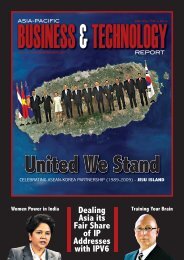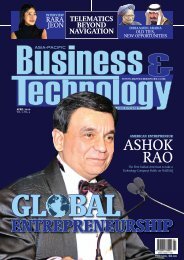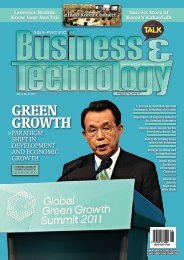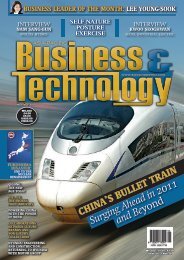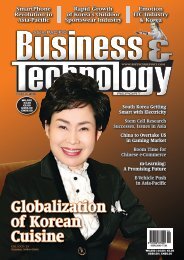INDIA-KOREA - Asia-Pacific Business and Technology Report
INDIA-KOREA - Asia-Pacific Business and Technology Report
INDIA-KOREA - Asia-Pacific Business and Technology Report
You also want an ePaper? Increase the reach of your titles
YUMPU automatically turns print PDFs into web optimized ePapers that Google loves.
EDUCATION<br />
<strong>INDIA</strong>-<strong>KOREA</strong><br />
Glorious Past Bright Future<br />
Research Cooperation Between Indian Korean<br />
Institutes of Higher Learning<br />
by Chung-Yeon Cho<br />
India is known for<br />
its exhaustive depth<br />
of professionals –<br />
engineers, doctors, research<br />
scientists <strong>and</strong> other sciencebased<br />
fields – particularly<br />
for their committed <strong>and</strong><br />
dedicated work ethic<br />
driving their excellence.<br />
However, it comes as a surprise that research-related<br />
activities are not as mature<br />
with regard to Korea academicians.<br />
Hence, the need of the year between India<br />
<strong>and</strong> Korea, even as both countries celebrate<br />
their 40 years of co-operation <strong>and</strong><br />
trade, is to collaborate further so as to complement<br />
each other’s proficiencies.<br />
Indian application development <strong>and</strong> analytical<br />
skills are well-known for their excellence.<br />
The Korean focus on research <strong>and</strong><br />
development has been this country’s main<br />
driving force to be the world leader in semiconductor<br />
technology as well as mobile<br />
computing <strong>and</strong> other electronic-domain<br />
products.<br />
In the past couple of years both these<br />
countries have established an effective<br />
channel for exchange of students through<br />
the establishment of the Academy of Korean<br />
Studies in India. Universities within Korea<br />
such as Busan University have shown a<br />
keen interest in admitting Indian students.<br />
Indian students interested in research,<br />
development or doctoral/post-doctoral studies<br />
should head to South Korea <strong>and</strong> are welladvised<br />
to consider the quality of research<br />
<strong>and</strong> leading-edge technology innovation<br />
happening there, especially in the semiconductor,<br />
solar PV <strong>and</strong> related sectors.<br />
While India has ‘new temples’ of learning<br />
of ‘Indian Institute of Management <strong>and</strong><br />
Technologies,’ Korea has integrated educational<br />
methodology where technology is being<br />
utilized even at the kindergarten level<br />
of education.<br />
© pib.nic.in<br />
Smt. Gursharan Kaur paying floral tributes at the statue of<br />
Guru Rabindra Nath Tagore, in Seoul on March 26, 2012.<br />
As Koreans seek the hallowed portals of<br />
IIT’s <strong>and</strong> IIMs for quality educational opportunities,<br />
Indian students in Korea are keen<br />
on inculcating research <strong>and</strong> development<br />
techniques which have created the technically<br />
advanced nation that South Korea has<br />
become. A-P<br />
Continued from Page 43<br />
India is one of the 12 mega biodiversity<br />
centers of the world, including the Western<br />
Ghats <strong>and</strong> Eastern Himalayas region, which<br />
are reported to contain 49,000 plant species.<br />
Depending on the availability of principal<br />
medicinal plants, the country has been<br />
divided into eight phytogeographic regions.<br />
Research <strong>and</strong> Development Council of<br />
Scientific <strong>and</strong> Industrial Research (CSIR),<br />
is a leading research organization in India<br />
having 40 laboratories spread throughout<br />
the country. All universities <strong>and</strong> leading<br />
pharmaceutical institutes carry out research<br />
on medicinal plants. The knowledge<br />
of ancient texts has been translated<br />
<strong>and</strong> digitalized in the form of a Traditional<br />
Knowledge Digital Library (TKDL) to protect<br />
Intellectual Property Rights (IPR). Five gene<br />
banks have been established in the Central<br />
Institute of Medicinal <strong>and</strong> Aromatic Plants,<br />
in Lucknow.<br />
The <strong>Technology</strong> Information, Forecasting<br />
& Assessment Council (TIFAC), has identified<br />
45 medicinal plants which have been<br />
included for action in cultivation, post-harvest<br />
technology, processing, manufacturing,<br />
research, patenting <strong>and</strong> marketing. The<br />
present export volume of crude drugs from<br />
India st<strong>and</strong>s at 36,200 tonnes worth about<br />
US$24 million (Vasisht <strong>and</strong> Maninder, 2003).<br />
Ayurveda, Siddha <strong>and</strong> Unani are classical<br />
system which are organised in nature<br />
<strong>and</strong> are taught in colleges, grant degrees to<br />
practitioners <strong>and</strong> are incorporated into the<br />
official health care system. India has well<br />
integrated these systems into the national<br />
health care system <strong>and</strong> they are officially<br />
recognized by the central <strong>and</strong> state governments.<br />
The Vaidyas <strong>and</strong> Hakims are still<br />
practicing in different parts of the country<br />
<strong>and</strong> today they are also getting recognition.<br />
Other steps have also been taken to<br />
strengthen this knowledge system.<br />
Conclusion<br />
Traditional medicine is not in isolation<br />
<strong>and</strong> there is an urgent need to have coordination<br />
between it <strong>and</strong> modern medicine<br />
systems. Both should communicate in one<br />
common language in order to provide better<br />
reach <strong>and</strong> benefits to humankind. To<br />
achieve this there needs to be a quality<br />
framework <strong>and</strong> design of traditional medicines,<br />
as well as appropriate st<strong>and</strong>ards for<br />
traditional medicine practice <strong>and</strong> products.<br />
Academic education in traditional medicine<br />
system has been offered in South Korea<br />
for many years. Mutual benefits should be<br />
shared in terms of technology transfer in<br />
health care systems, especially drug safety<br />
<strong>and</strong> efficacy, <strong>and</strong> quality strategy building<br />
for mutual cooperation. Medical Tourism is<br />
a very happening term nowadays, especially<br />
in <strong>Asia</strong>n continents, particularly in India<br />
<strong>and</strong> South Korea. India’s medical tourism<br />
sector is expected to experience an annual<br />
growth rate of 30 percent. South Korea is<br />
also listed among one of the prime destinations<br />
for medical tourism.<br />
Good sustainable harvesting practices,<br />
medicinal plants conservation <strong>and</strong> its cultivation,<br />
skill training, <strong>and</strong> product marketing<br />
are some key steps to be taken to ensure<br />
the betterment of the health system. The<br />
government endeavor will contribute to the<br />
preservation of biodiversity <strong>and</strong> improvement<br />
in its health care system. Coordination<br />
<strong>and</strong> cooperation between India <strong>and</strong><br />
South Korea for mutual benefits will bring<br />
significant positive results which can reestablish<br />
various treasured traditional medicine<br />
systems the world over. A-P<br />
References:<br />
• MDG Study Series, Achieving the Health<br />
Millennium Development Goals in <strong>Asia</strong><br />
<strong>and</strong> the <strong>Pacific</strong> Policies <strong>and</strong> Actions within<br />
Health Systems <strong>and</strong> Beyond <strong>Asia</strong>-<strong>Pacific</strong>.<br />
47<br />
www.biztechreport.com<br />
MDG Study Series, New York,<br />
• Jo, B H. (1990). The analysis of conflict<br />
structure of Korean medical system. Economics<br />
<strong>and</strong> Management, 23: 357-366.<br />
• Choi, D. W., Kim, J. H., Cho, S. Y., Kim, D.<br />
H. <strong>and</strong> Chang, S. Y.(2002). Regulation <strong>and</strong><br />
quality control of herbal drugs in Korea,<br />
Toxicology, 181-182: 581-586<br />
• Kala, C.P. (2004). Studies on the Indigenous<br />
Knowledge, Practices <strong>and</strong> Traditional Uses<br />
of Forest Products by Human Societies<br />
in Uttrakh<strong>and</strong> State of India. GB Pant<br />
Institute of Himalayan Environment <strong>and</strong><br />
Development, Almora.<br />
• Sahai, S. ( 2000). Commercialization of indigenous<br />
knowledge <strong>and</strong> benefit sharing,<br />
In: UNCTAD Expert Meeting on Systems<br />
<strong>and</strong> National Experiences for Protecting<br />
Traditional Knowledge, Innovations <strong>and</strong><br />
Practices, Geneva.<br />
• Sharma, S. K., (2002). Ayurvedic drugs production,<br />
regulatory status in India, domestic <strong>and</strong><br />
export market, In: Workshop on Regulations<br />
for Production <strong>and</strong> Marketing of Medicinal<br />
Plant Products, ICS-UNIDO, Trieste (Unpublished<br />
document)<br />
• Vasisht, K. <strong>and</strong> Maninder, K. (2003). The<br />
status of medicinal <strong>and</strong> aromatic plants in<br />
India <strong>and</strong> Nepal, In: Vasisht K. <strong>and</strong> Kumar<br />
V. (Eds.), Medicinal Plants <strong>and</strong> Their Utilization,<br />
ICS-UNIDO, pp. 55-75<br />
• WHO (2001) Legal Status of Traditional<br />
Medicine <strong>and</strong> Complementary/Alternative<br />
Medicine: A Worldwide Review, WHO/<br />
EDM/TRM/200 1.2, WHO, Geneva, p. 188<br />
• WHO (2005) National Policy on Traditional<br />
Medicine <strong>and</strong> Regulation of Herbal<br />
Medicines: <strong>Report</strong> of a WHO global survey,<br />
WHO, Geneva, May 2005. Available<br />
at: http://whqlibdoc.who.int/publications/2005/9241593237.pdf<br />
(15 Feb. 2006)



